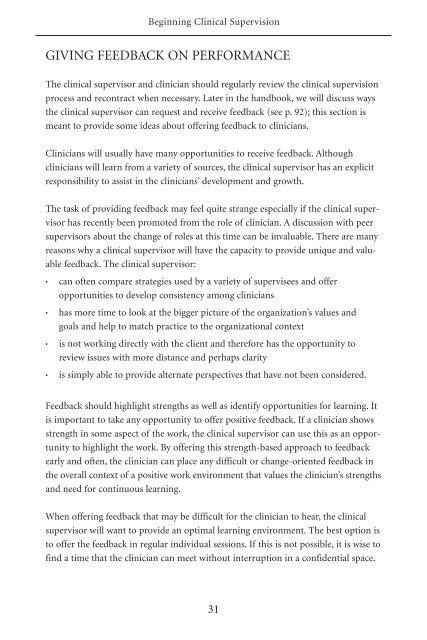Clinical Supervision Handbook - CAMH Knowledge Exchange ..
You also want an ePaper? Increase the reach of your titles
YUMPU automatically turns print PDFs into web optimized ePapers that Google loves.
Beginning <strong>Clinical</strong> <strong>Supervision</strong><br />
GIVING FEEDBACK ON PERFORMANCE<br />
The clinical supervisor and clinician should regularly review the clinical supervision<br />
process and recontract when necessary. Later in the handbook, we will discuss ways<br />
the clinical supervisor can request and receive feedback (see p. 92); this section is<br />
meant to provide some ideas about offering feedback to clinicians.<br />
Clinicians will usually have many opportunities to receive feedback. Although<br />
clinicians will learn from a variety of sources, the clinical supervisor has an explicit<br />
responsibility to assist in the clinicians’ development and growth.<br />
The task of providing feedback may feel quite strange especially if the clinical supervisor<br />
has recently been promoted from the role of clinician. A discussion with peer<br />
supervisors about the change of roles at this time can be invaluable. There are many<br />
reasons why a clinical supervisor will have the capacity to provide unique and valuable<br />
feedback. The clinical supervisor:<br />
• can often compare strategies used by a variety of supervisees and offer<br />
opportunities to develop consistency among clinicians<br />
• has more time to look at the bigger picture of the organization’s values and<br />
goals and help to match practice to the organizational context<br />
• is not working directly with the client and therefore has the opportunity to<br />
review issues with more distance and perhaps clarity<br />
• is simply able to provide alternate perspectives that have not been considered.<br />
Feedback should highlight strengths as well as identify opportunities for learning. It<br />
is important to take any opportunity to offer positive feedback. If a clinician shows<br />
strength in some aspect of the work, the clinical supervisor can use this as an opportunity<br />
to highlight the work. By offering this strength-based approach to feedback<br />
early and often, the clinician can place any difficult or change-oriented feedback in<br />
the overall context of a positive work environment that values the clinician’s strengths<br />
and need for continuous learning.<br />
When offering feedback that may be difficult for the clinician to hear, the clinical<br />
supervisor will want to provide an optimal learning environment. The best option is<br />
to offer the feedback in regular individual sessions. If this is not possible, it is wise to<br />
find a time that the clinician can meet without interruption in a confidential space.<br />
31


